|

Special
Issue, December 11 and 12, 1999
Mycological Society of San Francisco (MSSF)
Fungus Fair
by Herman Brown
herman@fungi-zette.com
Back to FUNGUS FAIRS
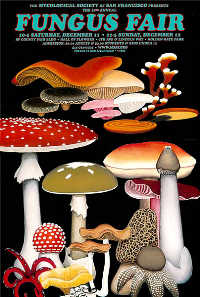
Fair Poster
The following material was donated
by some of those who attended the December, 1999 Mycological
Society of San Francisco (MSSF) Fungus Fair.
I was unable to go, so I solicited
pictures and comments from the members of the MSSF OneList (MSSF electronic mailing list), and collected what I could off the MSSF OneList postings.
What follows is a result of that
solicitation and collecting.
A note from Barbara Sommer:
I heard that there were 1,000
people in attendance on Saturday, but
that is 2nd hand information. I was only there on Sunday
and it did not seem like there were that many people --
but the turnout was good. The Amanita table was a big
draw -- as always, and people were interested in the
deliquescing shaggy manes and blue-staining Psilocybes
(see species list).
- Barbara
The Fair
The following is a brief
description of the Fair, posted on the MSSF Onelist by Yu-Shen Ng:
Hi,
I'd like to invite
you to the SF Fungus Fair, to be held in Golden Gate Park at
the Hall of Flowers on December 11 and 12. The Hall of
Flowers (also named the SF County Fair Building) is located
near 9th and Lincoln in San Francisco. Here's some more
information about the Fair:
Explore the world of
mushrooms. See thousands of mushrooms on display, learn to
find and identify mushrooms, cook with wild mushrooms, and
listen to experts on psychedelics, poisonings, medicinal
uses, and more.
Saturday,
12/11, 10am-5pm, and Sunday, 12/12, 11am-5pm.
County Fair
Building (generally known as the Hall of Flowers)
in Golden Gate Park, San Francisco
$6
adults/$3 students with ID and children under 12
Full details at: http://www.mssf.org/
Anyone with a
passion for the outdoors and an interest in mushrooms will be
able to get a hands-on introduction to the beauty, smells and
tastes of the world of mushrooms.
Over a thousand
specimens of local mushrooms will be on display at the fair,
and visitors will learn, first hand, how to distinguish the
deadly poisonous mushrooms from the choice edibles. Mushrooms
will be displayed in a setting that assists in their
identification and mimics their natural habitat.
EXPERTS TO COVER
PSYCHEDLIC EFFECTS, MEDICINAL USES, DIVERSITY AND BEAUTY OF,
AND ECOLOGY OF MUSHROOMS
Speakers at the fair
will focus on various roles of mushrooms in our society.
Multiple speakers will address ethnocultural aspects of
mushrooms, including psychedelic mushrooms.
Internationally-renowned photographer Taylor Lockwood will
present a multimedia show about exotic mushrooms from around
the world: "Treasures from the Kingdom of Fungi."
Dr. Mo-Mei Chen, Professor of Mycology at the Chinese Academy
of Forestry in Beijing, and currently a visiting professor at
UC-Berkeley, will discuss medicinal uses of mushrooms. Janet Doell, of the
California Lichen Society, will give a
multimedia presentation on "Lichens Exposed." Mike Boom, past president of the
Mycological Society of San Francisco, will teach beginners how to safely hunt and
identify wild mushrooms.
JUST FOR KIDS
Middle and high
schools students will enjoy and appreciate most fair
activities, and younger students can also participate in
artist and author Louise Freedman's Kid's Area. The Kid's
Area will provide opportunities to learn about a select set
of mushrooms, participate in a mushroom drawing contest, and
"hunt" for specific mushrooms among the display
tables.
COOKING
DEMONSTRATIONS
Cooking shows will
be held throughout the day. Francis Wilson, head chef at
LaLime's in Berkeley, will demonstrate techniques and recipes
for preparing choice wild mushrooms available in the Bay
Area. Several other chefs will also be showcasing mushroom
cooking techniques.
ORGANIZED
MUSHROOM HUNTING FORAYS
In addition to
viewing displays and presentations, fair visitors can
participate in "mushroom-hunting" by joining one of
the pre-fair "mushroom forays." On Friday and
Saturday, December 10 and 11, several teams of experts will
invite fair-goers to hike through forests, hillsides, trails,
and seashores to collect mushrooms throughout the Bay Area.
To participate in any of the pre-fair forays, call the
Mycological Society of San Francisco's (MSSF's) hotline at
415-759-0495.
The Fungus Fair is
not a crafts fair; some mushroom related items, however,
including mushroom dyed clothing, posters, and growing kits,
will be available for sale.
ABOUT THE SOCIETY
The Mycological
Society of San Francisco is a non-profit organization
dedicated to the promotion of educational and scientific
activities involving mushrooms. The MSSF is the largest
regional mushroom society in the United States, and has over
800 members. Founded in 1950, the society is now celebrating
its 50th anniversary. The society awards a yearly scholarship
to a Northern California graduate student of Mycology,
maintains a species database used by city, county and state
parks, provides expertise to Bay Area poison control centers,
leads identification walks and works to preserve cultural
traditions of mushroom collecting.
The Fair Schedule of Events
top
The following schedule was posted on the MSSF OneList by Mark Thomsen:
Saturday, December
11th
Outdoor Cooking
demonstration
12:00 PM - 1:30 PM John Pisto, chef,
restaurateur, author, television personality and
mushroom aficionado will be cooking up a wild mushroom risotto.
There will be liberal samples at the end of the show. John has
been delighting audiences with his love of mushrooms and cooking
for years.
Auditorium
11:00 AM - 12:00 PM Lichens
Exposed. A multi media presentation on lichens by Richard Doell
of the California Lichen Society.
12:30 PM - 1:30 PM Beginning
mushrooms. A slide show presentation on the basics of fungi by
MSSF past president Mike Boom. This is a general introduction to
mycology and a tour of common California mushrooms.
2:00 PM - 3:00 PM Treasures
from the Kingdom of Fungi. An awesome slide and musical show by
Taylor Lockwood, one of the most talented photographers of
mushrooms around. This really is a special presentation.
Lecture Room
11:30 AM - 12:30 PM California's
rich mushroom heritage. A slide show and lecture by Dr. Mo-Mei Chen,
professor of forest pathology and mycology at UC Berkeley/Jepson
Herbaria and at the UC Forest Products Lab.
1:00 PM - 2:00 PM Buddhist
saints on drugs: Mushrooms in the history of religion by Scott
Hajicek-Dobberstein.
2:30 PM - 3:30 PM Intro
to Enthnomycology, the discovery of psychedelic mushrooms by the
West. Part 1. A presentation by James Arthur.
4:00 PM - 5:00 PM A
slide show presentation of 19th century American artist Mary Banning's mushroom illustrations.
Sunday, December 12th
Outdoor Cooking
demonstration
12:00 PM - 1:30 PM Frances Wilson, executive chef at
Lalime's restaurant in Berkeley will be
preparing a variety of wild mushroom dishes including a candy cap
creme brulé. Frances teaches classes in cooking with wild
mushrooms at various Bay Area locales.
Auditorium
11:30 AM - 12:30 PM Lichens
Exposed. A multi media presentation on lichens by Richard Doell
of the California Lichen Society.
1:00 PM - 2:00 PM Photographing
mushrooms. This is a workshop with tips and techniques on
photographing fungi by our (MSSF) webmaster Mike Wood and past president
Fred Stevens.
2:30 PM - 3:30 PM Treasures
from the Kingdom of Fungi. An awesome slide and musical show by
Taylor Lockwood, one of the most talented photographers of
mushrooms around. This really is a special presentation.
Lecture Room
1:00 AM - 2:00 PM California's
rich mushroom heritage. A slide show and lecture by Dr. Mo-Mei Chen,
professor of forest pathology and mycology at UC Berkeley/Jepson
Herbaria and at the UC Forest Products Lab.
2:30 PM - 3:30 PM Intro
to Enthnomycology, mushrooms and shamanism Part 2. A presentation
by James Arthur.
4:00 PM - 5:00 PM A
slide show presentation of 19th century American artist Mary Banning's mushroom illustrations.
Barbara Sommer's
pictures
top
Barbara used a Sony Mavica MVC 83 digital camera set in the high resolution
mode. I reduced the resolution as necessary to fit my screen
|
The Culture Table
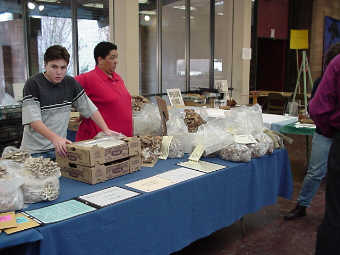
|
A customer?
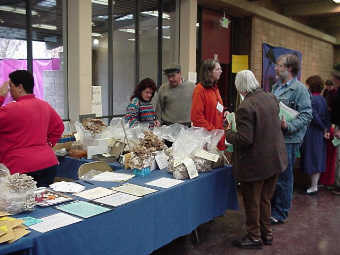
|
Bob Sommer
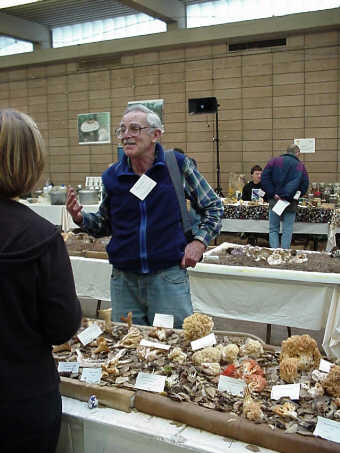
|
Bob's table

|
Lots of 'Shrooms

|
A nice setting
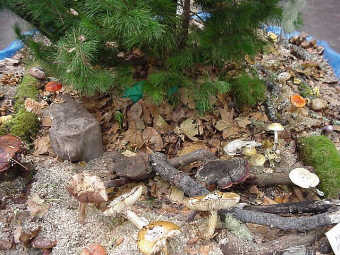
|
A few Ramaria (and others)
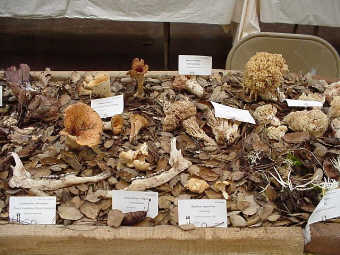
Mike
Wood's table
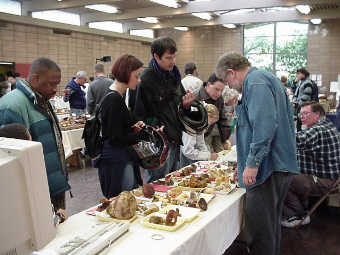
|
Fred Stevens, The ID Wizard

|
A display about mushroom
identification
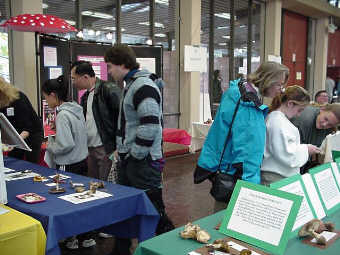
|
Hypholoma aurantiacum
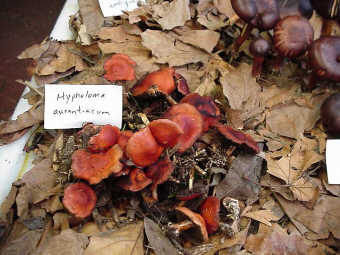
|
Mushroom growing kits available
for purchase

|
Help on the edibility of
mushrooms
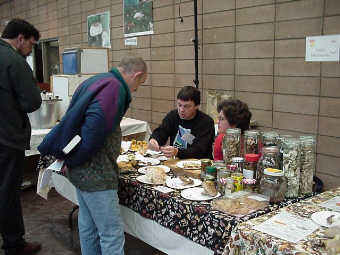
|
Display about the ecological
value of fungi
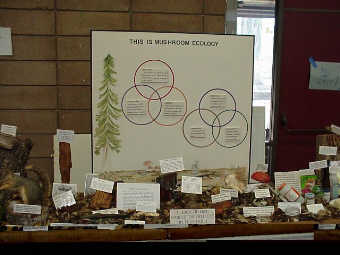
|
The Amanita table
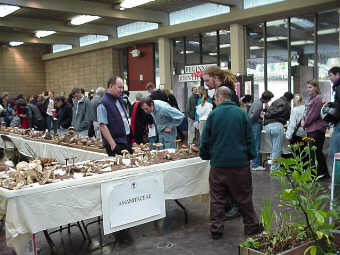
|
|
Specie List (from Mike Wood)
top
The IDs were done by Dr. Dennis
Desjardin, Michael Wood,
Fred Stevens, J. R. Blair, and Norm Andresen
|
|
















